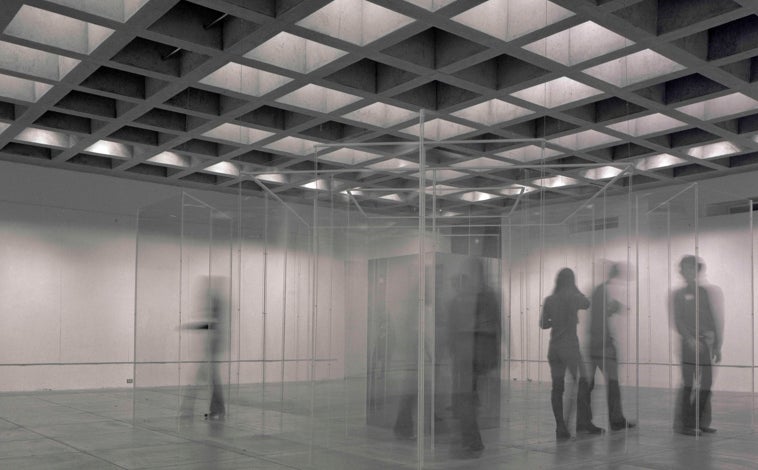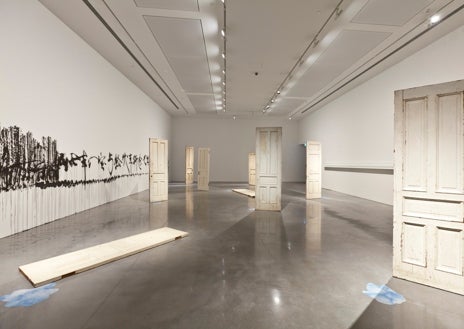The MUSAC in León will host the largest Yoko Ono exhibition in Spain.

Entitled 'Yoko Ono. Insound and Instructure' , the Museum of Contemporary Art of Castilla y León will be hosting an ambitious exhibition beginning November 8th that explores the artist's career from the 1960s to the present day through 70 works.
More than 1,700 square meters of exhibition space will celebrate the relevance and significance of the work of this pioneering artist of conceptual and participatory art, film and performance, musician, and world peace activist. The exhibition's title derives from a Yoko Ono concert and exhibition that took place on July 20, 1964, at 6 p.m., in Kyoto's Yamaichi Hall. Both terms refer to the way Yoko Ono integrates sound and instruction into her artistic practice.
The starting point for many of Ono's works is found in the "Instructions," text-based works that invite the reader to imagine, experiment, create, or complete the piece. Ideas, not materials, are the main component of the artist's practice. The exhibition at MUSAC includes more than 70 pieces that, based on these concepts, trace a historical journey through Ono's career from the 1960s to the present. "Yoko Ono. Insound and Instructure" will be on view until May 17, 2026, and is curated by Jon Hendricks, Connor Monahan, and Álvaro Rodríguez Fominaya.
The exhibition encompasses a wide variety of techniques Yoko Ono has worked with, from performance, film, music, installation, painting, and photography. The selection includes some of her most recognized works, including iconic pieces from the 1960s such as 'Cut Piece' (1964), 'Voice Piece for Soprano' (1961), and 'Draw Circle Painting' (1964), which require audience participation. This audience participation is one of the unique themes that define her creation. Among the participatory works that can be experienced are 'A Maze' (1971), a traversable labyrinth, and 'En Trance' (1990), an architectural construction that serves as a preamble and entrance to the exhibition, bringing together the notions of transformation and play.
The exhibition at MUSAC is not only a unique opportunity to experience the artist's historic works, but also includes some of her most recent projects, such as the installation 'Doors' (2011) and 'Invisible Flags' (2015), which reiterates pacifism as one of her vital concerns. The exhibition also includes a wide selection of her films, partly made with John Lennon , including 'Rape' (1968), 'Fly' (1970/1971), and 'Freedom' (1970).



The exhibition is particularly relevant at a time when Yoko Ono's work is receiving international recognition from museums for its relevance and resonance in our times, with recent retrospectives at Tate Modern (London), the Neue Nationalgalerie (Berlin) and the Museum of Contemporary Art (MCA) in Chicago (USA).
Born in Tokyo in 1933, Yoko Ono grew up in Japan, spending periods in San Francisco and New York. She was the first woman admitted to the philosophy program at Gakushuin University in Tokyo before moving to New York in 1953 to study at Sarah Lawrence College. In 1956, she settled in Manhattan with her then-husband, composer Toshi Ichiyanagi. Immersed in a community of artists and composers, Ono developed her own artistic practice, often in the form of instructions that invited viewer participation.
In 1960, he rented a loft on Chambers Street in Lower Manhattan, where, together with composer La Monte Young, he organized performances and events that became integral to the emerging New York art and music scene. Many of his works from those years were also performed in that space. His first solo exhibition took place in 1961 at George Maciunas and Almus Salcius's AG Gallery, where he presented his Instruction Paintings , including "Painting to Be Stepped On." That same year, he gave a performance at Carnegie Recital Hall that included works that combined movement, sound, and voice, such as "AOS – To David Tudor" and "A Grapefruit in the World of Park."
In March 1962, she returned to Tokyo, presenting new performances at the Sogetsu Art Center, including 'The Pulse,' and exhibiting her 'Instructions for Paintings.' That same year, she performed with John Cage and David Tudor on a concert tour of Japan. In 1964, Ono presented 'Cut Piece' and 'Bag Piece' in Kyoto and Tokyo, and self-published 'Grapefruit,' her influential instruction book. Returning to New York in late 1964, Ono continued performing, organizing events, and exploring new ways to disseminate her art through advertising and mail-order events. She also continued writing instruction-based film scripts and making her own films, including 'Film No. 4,' 'Film No. 1' ('Match,') and 'Eyeblink/Fluxfilm No. 15.'
Invited to London in September 1966 to participate in the Destruction in Art Symposium, she remained there for several years. She exhibited at the Indica Gallery and the Lisson Gallery, presenting new object-based conceptual works such as 'White Chess Set,' 'Apple,' and 'Half-A-Room,' while continuing to make films and perform on her Music of the Mind tour. At her exhibition at the Indica Gallery, she met John Lennon, beginning a personal and artistic relationship spanning art, music, and activism.
In 1969, Ono and Lennon's peace initiatives—such as the "WAR IS OVER! If you want it" campaign and the "Bed-In for Peace" in Amsterdam and Montreal—made international headlines. Through these events, Ono expanded her conceptual practice toward a framework of political and social imagination, transforming art into platforms for global activism.
 John Lennon and Yoko Ono, during the 'Bed-in'
EFe
John Lennon and Yoko Ono, during the 'Bed-in'
EFe
Ono released four solo albums and four collaborations with Lennon, and made several films, including Fly, Freedom, Rape, Apotheosis, and Imagine. In 1971, she had her first museum retrospective, This Is Not Here, at the Everson Art Museum, and organized her unofficial conceptual exhibition, Museum of Modern [F]art, at the Museum of Modern Art in New York.
In 1980 they returned to the studio to record their first joint album since 1972. 'Double Fantasy' was released in November of that year and won the Grammy for Album of the Year in 1981. Less than a month after its release, Lennon was murdered outside his home in New York City on December 8, 1980. Following this loss, Ono turned to music, releasing several albums during the 1980s.
After a long absence from museums and galleries, her 1989 solo exhibition at the Whitney Museum of American Art, Yoko Ono: Objects, Film, signaled renewed recognition and interest in her work. In 2000, the retrospective "Yes, Yoko Ono," organized by the Japan Society Gallery in New York, toured thirteen international venues over a four-year period.
MORE INFORMATION
In 2007, Ono unveiled the Imagine Peace Tower on Viðey, an island off the coast of Reykjavik, Iceland, giving a permanent home to her and Lennon’s shared commitment to world peace. In 2009, she received the Golden Lion for Lifetime Achievement at the 53rd Venice Biennale. That same year, Ono released ‘Between My Head and the Sky’, her first album with the Plastic Ono Band since 1973. In 2018, she released her thirteenth solo album, ‘Warzone’. Ono’s work has continued to be recognized with numerous exhibitions at some of the world’s most prestigious venues, including The Museum of Modern Art, New York (2015), Museum of Contemporary Art, Tokyo (2015), Tate Modern, London (2024), and Neue Nationalgalerie, Berlin (2025).
ABC.es





